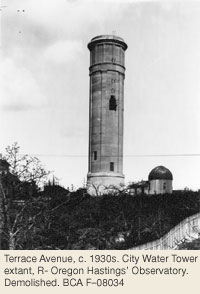 |
| photo by SteveRSVR |

BBC news slideshow http://www.bbc.co.uk/news/uk-england-northamptonshire-14983682
Here's map of the laser 'field' to aid viewing:
View flow towers in a larger map
BWTAS context:
Illuminating water towers has a long history and was commonplace when water towers were novel and objects of civic pride. The Thorpe Hamlet water tower in Norwich was illuminated for a year to commemorate George V's silver jubilee in 1935. A couple of generations later, illumination of towers was used as way of reasserting their monumental quality and renewing civic pride as part of regeneration schemes. Cranhill Arts Project in Glasgow illuminated their local tower a vibrant green with white spotlights and nearby the Craigend water towers were illuminated as part of Glasgow's reign as the European City of Culture. The city council's lighting strategy webpage asserts: "Good lighting helps to increase vitality and improve ambience. It contributes to a sense of identity and place, makes for a safer, friendlier environment and also supports and complements other regeneration initiatives."



 With Victoria’s population growing rapidly, the city water supply was quickly becoming inadequate, and 1909 saw construction of a 100,000-gallon concrete water tower. This must have seemed unsightly, among the villas and Garry oak meadows at one of the highest points of Rockland, but, along with the Smith Hill Reservoir, it constituted a stop-gap project to supply Victorians with water until the new system at Sooke Lake was built. The area around the water tower was known locally as Observatory Hill.
With Victoria’s population growing rapidly, the city water supply was quickly becoming inadequate, and 1909 saw construction of a 100,000-gallon concrete water tower. This must have seemed unsightly, among the villas and Garry oak meadows at one of the highest points of Rockland, but, along with the Smith Hill Reservoir, it constituted a stop-gap project to supply Victorians with water until the new system at Sooke Lake was built. The area around the water tower was known locally as Observatory Hill.



